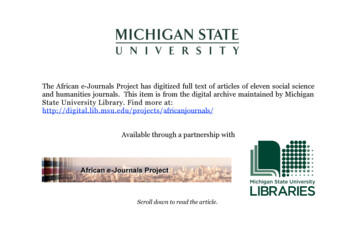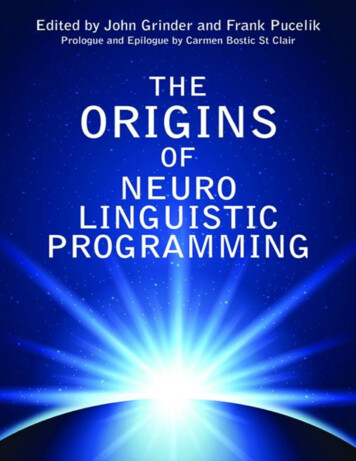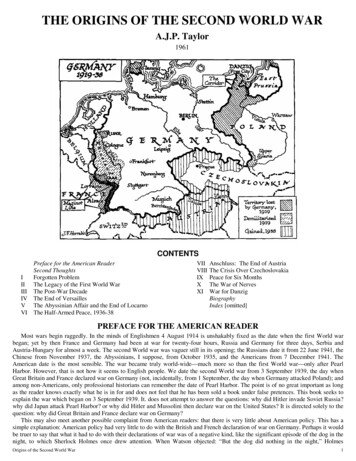
Transcription
To purchase the accompanying PowerPoint and Instructor’s Guide ( 20), or toorder printed s/originsc.htmTo access this .pdf file on the Web .pdfThe Origins of theNew TestamentWritten by Robert C. JonesAcworth, Georgia 1998, 2008 Robert C. Jones
Christian Theology and History Adult Sunday School CoursesRobert Joneswww.sundayschoolcourses.comI’ve always been a strong believer in adult Sunday School classes and Bible studies in our churches. And manychurches have quality, Biblically-based adult-focused programs. Unfortunately, just as many churches tend todownplay adult education, focusing on children’s education (not a bad thing in itself), or focusing on the needs ofthe “unchurched”, where topics such as church history and theology are often purposely ignored.Yet there is a strong need for adult education focused on both the Bible and the basic tenets and history of theFaith. Among the reasons: Not all adults come from a strong childhood background in the church – adult Sunday School classes/Biblestudies may be their first serious intro-duction to what Christianity is all aboutChristianity (and especially Evangelical Christianity) is under constant at-tack from the media and popularculture (movies, music, etc.). We need to give fellow Christians the tools to defend the Faith against attack (or to provide a “ready defense” as Peter says in 1 Peter 3:15)Even adult Christians that have a strong Biblical background often know little about the origins and historyof their FaithTo better meet the needs of adult Christians (both those mature in their Faith, and those just starting out in the“School of Christ”), I’ve written a series of courses that focus on the history of the Christian Church (including theJewish roots), as well as the development of doctrine in the Church. The topics represented in these courses areintended to both further the participant’s walk in the Faith, as well as serve as a starting point for Christian apologetics.While the primary purpose of these courses is for use in churches, they also may be useful for High School and College projects, especially the courses focused primarily on historical aspects.One note: these courses are primarily written from an Evangelical Protestant view-point (I come from a ReformedChurch background), but I hope I've given ample time to other points of view throughout the various courses.Front Cover: Library of Congress LAMB, no. 698 (AAA size) [P&P]2
The Origins of the NewTestamentWritten by Robert JonesAcworth, Georgia 1998, 2008To purchase the accompanying PowerPoint and Instructor’s Guide ( 20), or toorder printed s/originsc.htmTo access this .pdf file on the Web .pdfTo watch a free video extract of the author teaching this course:http://www.youtube.com/watch?v tkzA6Rr0H5U"Scripture taken from the HOLY BIBLE, NEWINTERNATIONAL VERSION. Copyright 1973,1978, 1984 by International Bible Society. Used bypermission of Zondervan Publishing courses.com3
Table of ContentsChristian Theology and History Adult Sunday School Courses . 2Table of Contents . 4Introduction . 5New Testament quiz . 6The origins of the New Testament. 6The Gospels . 6Who wrote the Gospels? . 7The letters. 8The Apocalypse . 9Writings by Jesus? . 9Dating of the New Testament . 9Creation of the New Testament canon . 11Criteria for inclusion in the canon . 11The Early Church Fathers . 13Papias (c. 70-155 A.D.) . 14Irenaeus (Bishop of Lyons from 177-202 A.D.) . 14Origen (185-253 A.D.). 15Clement of Alexandria (c. 150-212 A.D.) . 15Forming the canon. 16Marcion - the first attempt at a canon . 16Muratori Canon (c. 200 A.D.) . 17Eusebius (c. 260 - c. 340 A.D.) and his Ecclesiastical History . 17Athanasius (c. 296-373 A.D.) . 20The Councils of Hippo and Carthage . 20Other voices . 21Important developments after the creation of the canon . 21Books that almost made the New Testament . 23Revelation of Peter . 23Epistle of Clement to the Corinthians. 24Epistle of Barnabas . 25The Shepherd (Pastor) of Hermas . 26Who is the shepherd? . 28Other books not deemed canonical. 28Sources . 294
IntroductionThis purpose of this booklet is to examine the origins of the New Testament, including who wrote it andwhen, as well as the process by which the books that make up our modern day New Testament weredeemed "canonical", or authoritative.".For it is not to be accounted of no consequence, that, from the first publication of Scripture, so manyages have uniformly concurred in yielding obedience to it, and that, notwithstanding of the many extraordinary attempts which Satan and the whole world have made to oppress and overthrow it, or completelyefface it from the memory of men, it has flourished like the palm tree and continued invincible." (JohnCalvin, "Christian Institutes", p. 113/114)In my experience as a Christian (first, as a Schwenkfelder, later as a Presbyterian), I have noted withsome dismay that the subject of how the 27 books that make up the Protestant and Roman CatholicNew Testament became canonical is often vaguely addressed by the Church. Generally, the hazy answeris that a group of bishops convened a council in the fourth century (usually incorrectly attributed to theCouncil of Nicea in 325 A.D.), and selected the books that we now have in our New Testament.While this hazy outline contains some elements of truth (there were fourth century councils on the topic, at Hippo and Carthage), it can give the false impression that the books of the canon were somewhatarbitrarily selected by an arbitrary group of church leaders 300-400 years after they were written. Onemight excuse the skeptic for questioning the validity of such a methodology for such an important (andlasting) decision.The reality is somewhat different. The various councils of the fourth century did indeed vote on a NewTestament canon, but the process was far from arbitrary. Rather, the learned bishops merely put theirstamp of approval on a corpus of works that had been in constant use in the Christian Church since thefirst century, and that were quoted from liberally by the earliest church fathers (the "Ante-Nicene", orpre-Council of Nicaea church fathers). While there were some controversies and compromises betweenthe Eastern and Western churches in terms of the final canon (Hebrews was popular in the EasternChurch, the Apocalypse in the Western), no books were chosen that weren't already in common use ineither the former or the latter (and the great majority were in use in both).In addition, I will discuss the mysterious books that "almost made it" into the canon, but were rejectedin the final cut. Books such as the Shepherd of Hermas, the Epistle of Clement to the Corinthians, theEpistle of Barnabas, and the Revelation of Peter all appeared on various proposed canonical lists (orwere referenced by Early Church Fathers) throughout the first three centuries of the church. While itwas eventually decided that they were not of apostolic origin, and therefore should not be contained inthe canon, they were still viewed by the early church fathers as useful to those "who newly join us, andwho wish for instruction in the word of godliness". Even with that recommendation, these books arenot only not used in the church today, but have practically disappeared from public view.Finally, I will discuss some of the major New Testament events since the creation of the canon in the latefourth century (with an emphasis on the creation of English-language translations).Hopefully, this booklet will help elucidate how the New Testament became the book we as Christians,cherish today.5
New Testament quiz1. At least one of the four Gospels lists the author within the text (T/F)2. The modern day New Testament canon was decided upon by a group of bishops at the Council ofNicea in 325 A.D. (T/F)3. Martin Luther was especially enamoured of the Book of James (T/F)4. There was great debate regarding whether there should be more than four Gospels in the canon, atthe fourth century councils (T/F)5. The Gospel of Thomas was known, and rejected, by the Church Fathers (T/F)6. The oldest extant piece of any part of the New Testament is from the Gospel of John, dating to approximately 125 A.D. (T/F)7. One book of the New Testament that was universally agreed upon for inclusion into the canon wasthe Book of Hebrews (T/F)8. The one-time existence of a Lost Gospel of Q is a proven historical fact (T/F)GlossaryBible - from the Greek word biblia, meaning "books"Canon - from the Semitic word for "reed"; in Greek, it became to mean a standard measure or rule (kanon); as pertaining to the Bible, it is the list of books considered authoritative by the Early Church FathersGospel - from the Greek evangelion, meaning "good news"Koine - the common Greek used to write most of the New TestamentVulgate - the common (or "vulgar") Latin used in Jerome's translation of the BibleThe origins of the New TestamentThe New Testament, of course, is not a single book, but rather a collection of books (gospels, letters, anapocalypse) written over a period of several decades in the latter part of the first century. The primarypurpose of the books that were later called the "New" Testament (to distinguish them from the "Old"Jewish scriptures) was to record and pass on the gospel ("good news") of Jesus Christ.The GospelsThe word "gospel" comes from the Greek word evangelion, meaning "good news". (Other words incommon usage that come from the same root include evangelical and evangelist.) Gospels are notmeant to be histories - they were not written as a "Life and Times of Jesus Christ", but rather to convince people that Christ was both the promised Messiah of the Hebrew Scriptures, and, more importantly, the very Son of God. John 20:31 records:"But these are written that you may believe that Jesus is the Christ, the Son of God, and that by believingyou may have life in his name." (John 20:31, NIV)However, John, who wrote the longest of the four Gospels, goes on to point out that no attempt hasbeen made to record everything that Jesus said and did:"Jesus did many other miraculous signs in the presence of his disciples, which are not recorded in thisbook." (John 20:30, NIV)6
"Jesus did many other things as well. If every one of them were written down, I suppose that even thewhole world would not have room for the books that would be written." (John 21:25, NIV)Sometimes people question why the Gospels were written so long after the death and resurrection ofChrist. Assuming that Christ died around 30 A.D., even early datings of Mark (before 50 A.D.) would stillput the first written Gospel 15 or more years after the death and resurrection of Christ. Why so long?Two possible answers follow: The apostles and the original disciples spread the word throughout the Mediterranean (and perhapsbeyond) primarily through word of mouth. It was not viewed that there was any reason to write themessage down, until the apostles and disciples (those that had actually seen Jesus) started to dieoff.The apostles and disciples probably held the view that the Second Coming of Christ was imminent,and thus felt no immediate need to record the word that they were spreading for posterity. As decades stretched on, it became apparent that the Second Coming was not imminent, and more carewas taken to make a record of the origins of the faith for future generations.The first three Gospels (Matthew, Mark, and Luke) are referred to as the "synoptic" Gospels, becausethe have a great deal of common material. J. Phillip Hyatt in his "Heritage of Biblical Faith" notes:"Of the 661 verses in Mark, Matthew has about 600 in substance or actual wording, and Luke has about350. Altogether, only 31 verses of Mark fail to appear also in Matthew and Luke. On the other hand,Matthew and Luke have between 200 and 250 verses in common that are not found in Mark, consistingchiefly of sayings of Jesus."Given the above set of statistics, many modern Biblical scholars assume that Mark is the oldest Gospel,and that it formed the basis for Matthew and Luke. The additional portions of Matthew and Luke notcontained in Mark are viewed to be from yet a fourth source, mysteriously designated as "Q" (Germanfor quelle, or "source".) Some scholars are so convinced that there must have been a "sayings" sourcefor Matthew and Luke that they sometimes refer to the five Gospels - Matthew, Mark, Luke, John, and"Q". However, it should be noted that there is not a single scrap of evidence that "Q" ever existed - it isnot referred to by any of the Early Church Fathers, nor is there any historical or archaeological evidenceof its existence. It should be noted also, that the Early Church Fathers identified Matthew (and Luke) asthe first Gospels to be written (see section on "The Early Church Fathers" below)."Try to imagine flying to a non-existent island on an airplane that has not yet been invented. Even if thisimpossible trip were to take place during the thirteenth month of the year, it would not be as fantastic asthe tale, recently christened as scientific certainty by some New Testament scholars, concerning the 'LostGospel' of Q". (Is There a Gospel of Q?, Eta Linnemann, Bible Review, August, 1995)Who wrote the Gospels?Unfortunately, the Gospels themselves are silent on the question of authorship. Ourviews as to the identities of the four evangelists come from the Early Church Fathers(one, Bishop Papias, from as early as 110 A.D.)! The Early Church Fathers are clear asto the apostolic origin of the four Gospels - Matthew and John writing first hand accounts, and John Mark (Acts 12:12, Acts 12:25, Acts 15:37, 1 Peter 5:13) and Luke thePhysician (Col 4:14, 2 Tim 4:11, Philemon 1:24) recording the words of Peter and Paul(respectively). The next chapter ("Creation of the New Testament canon") will inves-7
tigate the views of the Church Fathers on the topic of the Gospels in some detail. (Photo: Matthew,Mark, Luke, John1)Medieval depictions of the four evangelists often show them with a Bible in their hand - however, the original copies of the Gospels would have been written on papyri.The lettersThe majority of the New Testament is comprised of letters written by various figures that knew Jesus,including Paul (because of the Road to Damascus experience), Peter, John, James, and Jude (the lasttwo, brothers of Jesus). Most of these letters were written to address specific problems in specificchurches.At least 25% of the New Testament is made up of letters written by Paul of Tarsus, an early persecutor of Christians, but later the greatest of all Christian missionaries, and one ofthe greatest theologians. Paul's letters are among the oldest Christian documents still inexistence - they were probably all written between 49 - 66 A.D. (Graphic to right: theApostle Paul2)Paul's letters are proclaimed authoritative by none other than Peter himself:"He writes the same way in all his letters, speaking in them of these matters. His letters contain some things that are hard to understand, which ignorant and unstable people distort, asthey do the other Scriptures, to their own destruction." (II Pet 3:16, NIV)In general, there was never any question in the Early Church regarding the authentic Pauline-authorship of the letters attributed to him (except for Hebrews). As to the nonPauline (or "catholic") epistles, attributed to James, Jude, John, and Peter, controversies as to their actual authorship and authority would exist almost up to the time that the canon was fixed. This will bediscussed in more detail in the chapter entitled "Creation of the New Testament canon".12Library of Congress LAMB, no. 698 (AAA size) [P&P]Library of Congress LAMB, no. 790 (AA size) [P&P]8
The ApocalypseThe final book of the New Testament, Revelation, is written in the style and tradition of Jewish apocalyptic works, such as Daniel, Enoch, or II Esdras. It is traditionally ascribed to John the Apostle. It was, perhaps, the most controversial of all of the books finally accepted into the canon.Writings by Jesus?We are not aware of any extant writings by the focal point of the New Testament - Jesus Christ. Intriguingly, though, the New Testament does record an instant of Christ writing something - unfortunately,we are not told what it is:"They were using this question as a trap, in order to have a basis for accusing him. But Jesus bent downand started to write on the ground with his finger. When they kept on questioning him, he straightenedup and said to them, "If any one of you is without sin, let him be the first to throw a stone at her." Againhe stooped down and wrote on the ground." (John 8:6-8, NIV)Thus, while the New Testament contains the recorded words of Jesus, it contains no written works byChrist himself.Dating of the New TestamentWhen was the New Testament written? By tradition, it has long been assumed that the New Testamentwas completed by the end of the first century - in other words, within living memory of people whomactually knew Jesus of Nazareth. During the late 19th century a form of Biblical "scholarship" arose inGermany which greatly questioned a first century authorship of the New Testament, especially targetingthe Gospels. In this German view, the Gospels were really a product of a much later Christian Church,written perhaps centuries after the lives of the principals involved in the narratives.A special target of these German scholars was the Gospel of John, which was assumed to have beenwritten in the late second or even third century. By the turn of the century, though, (and continuing tothis day), archaeological discoveries have unearthed manuscripts much older than deemed possible bythe German scholars. Perhaps the most definitive nail in the coffin of this school of late dating of theNew Testament was the discovery in 1920 by Bernard Pyne Grenfell in a shop in Cairo of a fragment(now referred to as the Rylands Papyrus) of the Gospel of John that dates back to approximately 125A.D. The fragment contains the famous words "What is truth?" (John 18:38), an appropriate question toask Biblical "scholars" who impugn the veracity of the New Testament, without evidence. It should benoted, however, that many modern Biblical scholars still insist on late dating for the books of the NewTestament, blithely ignoring the archaeological findings of the past 100 years."In my opinion, every book of the New Testament was written by a baptized Jew between the forties andthe eighties of the first century A.D. (very probably sometime between about A.D. 50 and 75." - BiblicalArchaeologist William Foxwell Albright (Christianity Today, 1/18/63)BookMatthewMarkAuthorDateMatthew theApostleJohn Mark9 70 A.D.Possible reason forinclusion in the canon:Apostolic authorship55 A.D.Recorded the teach-
BookLukeJohnActsRomans1 Corinthians2 I Thess.II Thess.I TimothyII TimothyTitusPhilemonHebrewsJamesI PeterII PeterI JohnII JohnIII JohnJudeAuthorLuke the physicianJohn the ApostleLuke the physicianPaulPaulPaulPaulPaulPaulPaulPaulPaulPaul (somemodern scholarsquestion Paulineauthorship)Paul (somemodern scholarsquestion Paulineauthorship)PaulPaulunknown (possibly Paul, Apollos, Clement orBarnabas)James, brotherof JesusPeterPeter (somescholars feel thiswas written by afollower of Peter)John the ApostleJohn the Apostle(some scholarsfeel this waswritten by "Johnthe Elder")John the Apostle(see note for IIJohn)Jude, brother ofDate59 - 63A.D.85 - 93A.D63 A.D.Possible reason forinclusion in the canon:ings of Apostle PeterRecorded the teachings of Apostle PaulApostolic authorship57 A.D.55 A.D.55 A.D.50 A.D.60 A.D.61 A.D.60 A.D.51 A.D.51-52 A.D.64 A.D.Contemporary ofboth Peter and PaulApostolic authorshipApostolic authorshipApostolic authorshipApostolic authorshipApostolic authorshipApostolic authorshipApostolic authorshipApostolic authorshipApostolic authorshipApostolic authorship66 A.D.Apostolic authorship64 A.D.60 A.D. 70 A.D.Apostolic authorshipApostolic authorshipPossible apostolicauthorship - generallyaccepted as authoritative by the ECFApostolic authorship48 - 50A.D.64 A.D.66 A.D.Apostolic authorshipApostolic authorship90 A.D.90 A.D.Apostolic authorshipApostolic authorship90 A.DApostolic authorship65 A.D.Brother of Jesus10
BookAuthorDatePossible reason forinclusion in the canon:JesusJohn the Apostle 95 A.D.Apostolic authorship(see note for IIJohn)In general, dates are taken from the New International VersionRevelation ofJohnCreation of the New Testament canonThis section will trace the creation of the New Testament canon as it developed throughout the firstthree centuries after Christ. Before beginning this tracing, let us first take a look at the possible criteriafor inclusion in the New Testament (there is no extant list of criteria).Criteria for inclusion in the canonLet's say you are a fourth century Christian bishop. Within your lifetime, Christianity has gone from being an underground religion, to being the official religion of the Roman Empire. Amazingly, the emperorof that empire has accepted Christianity. Things are looking quite rosy indeed, for this upstart religion.But wait, there are also problems. Because Christianity has been underground for so many years,branches of The Church in different parts of the world have developed different traditions, and, in somecases, different theologies. And some people are even promulgating a pseudo-version of Christianitythat varies significantly from the traditional teachings of the Church. How to bring the various traditionstogether into one, united faith, worthy of an empire? How to combat the new heresies that seem to bespringing up and spreading like wildfire?An obvious way to deal with both problems would be to refer to the Holy Scriptures, which, after all,contain the revealed word of God. But wait - what scriptures are considered Holy? Amazingly, eventhough it is the fourth century (300 years after the time of Christ), there is no definitive list of authoritative Christian texts. So, first things first - create a canon (a list of authoritative texts) of books for theNew Testament.But how to choose the books to be included? By the fourth century, there are literally dozens of gospels, epistles, histories ("acts"), and apocalypses to choose from. Which ones should be considered forinclusion in the new canon? How to decide?Well, one criterion could be ancient authorship - certainly no later than the end of the first century. Sothat leaves out writings of the Early Church Fathers, such as Irenaeus, Origen, or Tertullian (although, ofcourse, their writings should still have an exalted place in the interpretative and historical panoply of thechurch).However, there were many writings from the first century that were written by people that never metChrist, and that varied wildly in their theological view from the theology of the Early Church Fathers.There must be some way to weed those (gnostic) writings out from the real writings of the Faith. So,another criteria for inclusion in this new canon would be apostolic authorship (either directly, or indirectly, through someone recording the words of an apostle).11
But even now, there are still difficulties - loose ends that heretical preachers will take advantage of tothe detriment of the Church. For example, how does one define an "apostle"? Just the original 12 (minus Judas, plus Matthias)? But gasp, what about Paul, who was not one of the twelve, or James, thebrother of Jesus, and head of the original Jerusalem church? What about Silas and Barnabas, the faithfulcompanions of Paul? And what about those that were the second generation, flowing like tributariesfrom the Pauline theological river, such as Clement (an early Bishop of Rome), or Papias? So, another cutis needed - the authors must have known Christ personally (or recorded the words of someone thatknew Christ personally). So, Paul, James, and Jude were in (Paul, because of the Road to Damascus experience), but Silas, Barnabas, Clement, and Papias were out.Well, you are almost there. The criteria is almost set, with one small problem - many of the writings thatcould fit the criteria you've established are unclear as to their authorship. For example, none of theGospels identify their author. And there are gospels that claim to have been written by apostles, but areclearly fraudulent. So one more criteria must be established - the writings for inclusion in the new canon must have been in general use and acceptance by the Early Church Fathers down to your own day.So now, our list of criteria is coming into focus: Ancient authorship.By people that personally knew Jesus.That have been in common use, and common acceptance within the Church since the time of theEarly Church FathersBut even with these criteria, there will still be some controversy. While there is a corpus of books accepted by all of the Church Fathers, in both the Eastern and Western branches of the church (the FourGospels, most of Paul's letters), there are other works accepted by some, but not all (II John, III John, IIPeter, Revelation of John, Revelation of Peter, Acts of Paul, etc.) Well, since the goal is to solidify thechurch, perhaps some compromise will be needed. And your job begins.The tale of our fictional fourth century bishop actually fits two important churchmen in the fourth century - Eusebius, and Athanasius. It is because of the work of these two men, and many others, that wehave a New Testament canon today.Datec. 45-95 A.D.2nd centuryc. 110 A.D.c. 125 A.D.c. 140 A.D.144 A.D.c. 150 A.D.c. 160 A.D.c. 180 A.D.EventBooks of the New Testament writtenCodex (modern form factor) of books developedPapias refers to the Gospels of Mark & MatthewEarliest extant fragment of any part of the NewTestament copied (John 18:38)Gnostic Marcion attempts first canonical listMarcion excommunicatedJustin Marty
Gospel - from the Greek evangelion, meaning "good news" Koine - the common Greek used to write most of the New Testament Vulgate - the common (or "vulgar") Latin used in Jerome's translation of the Bible The origins of the New Testament The New Testament, of course, is not a single book, but rather a collection of books (gospels, letters, an










